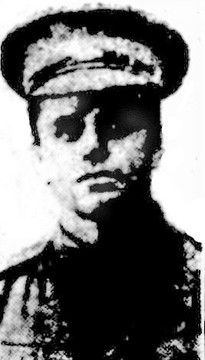Pte
William Lily Thomson
Informations sur naissance
|
Année de naissance: 1883 |
|
Lieu de naissance: Newcastle, New South Wales, Australia |
Informations générales
|
Profession: Miner |
Informations service militaire
|
Pays: Australia |
|
Force armée: Australian Imperial Force |
|
Rang: Private |
|
Numéro de service: 207 |
|
Incorporation date: 12/01/1916 |
|
Incorporation nom de lieu: Newcastle, New South Wales, Australia |
|
Unités: — Australian Infantry, 34th Bn. (Dernière unité connue) |
Informations sur décès
|
Date de décès: 12/10/1917 |
|
Lieu de décès: Keerselaarhoek, Belgique |
|
Cause du décès: Killed in action (K.I.A.) |
|
Âge: 34 |
Mémorial
|
Ypres (Menin Gate) Memorial Panneau: 25 A |
Distinctions et médailles 2
|
British War Medal Médaille |
|
Victory Medal Médaille |
Points d'intérêt 3
| #1 | Lieu de naissance | ||
| #2 | Lieu d'enrôlement | ||
| #3 | Lieu du décès (approximatif) |
Mon histoire
Private William Lily Thomson served in the 34th Battalion A.I.F., part of the 9th Australian Brigade, 3rd Australian Division. The 33-year old miner from Newcastle, New South Wales enlisted in January 1916 together with his younger brother James John. He was a boxer and fought at 8st. 41b. He proved himself to be such a strong fighter that no one in the West Wallsend district would meet him. He also won two boxing tournaments in Sydney.
The 34th Battalion took part in the First Battle of Passchendaele on 12 October 1917, part of the Battle of Passchendaele. The Battalion’s jumping off line was what is now Tyne Cot Cemetery, and its final objective lay just beyond Passchendaele village. The 34th Battalion was the first Battalion to advance, followed by the 35th and 36th Battalion.
At 5.25 a.m., the barrage came down. It was very weak and it was difficult to determine, which was the own barrage and which was German shell fire. The advance was slow. A first obstacle, were two concrete pillboxes. One in the north of Augustus Wood and one to the northeast of Heine House. German machine-gun fire from those positions caused several casualties and held up the center of the advance. Captain Jeffries organized a bombing party, which rushed the strongpoints. Four machine guns and 35 prisoners were captured. 150 yards in the rear of this strongpoint was a small trench in which were up to 30 Germans. An attacking party received the order to take control of the small trench. By now the 34th had suffered heavy losses and it was decided to send the entire battalion up with the 35th and 36th Battalion, in the attempt to take control over the next two objectives. The battalions reached the second objective, the Blue Line, but suffered heavy losses, from German machine gun- and shell fire. At 3 p.m., the Battalions received instructions to hold the line at all costs. Eventually a new line was constructed from Defy Crossing on the Ypers-Roulers Railroads to the direction of Waterfields.
According to the Red Cross Wounded and Missing file both brothers were hit by a (the same) shell. William was killed instantly. James was badly wounded at the left arm and side and started to walk back to the dressing station. After that he was never seen again. After the war the body of private William Lily Thomson was never retrieved and he is commemorated on the Ypres Menin Gate Memorial, 25 A.
The 34th Battalion took part in the First Battle of Passchendaele on 12 October 1917, part of the Battle of Passchendaele. The Battalion’s jumping off line was what is now Tyne Cot Cemetery, and its final objective lay just beyond Passchendaele village. The 34th Battalion was the first Battalion to advance, followed by the 35th and 36th Battalion.
At 5.25 a.m., the barrage came down. It was very weak and it was difficult to determine, which was the own barrage and which was German shell fire. The advance was slow. A first obstacle, were two concrete pillboxes. One in the north of Augustus Wood and one to the northeast of Heine House. German machine-gun fire from those positions caused several casualties and held up the center of the advance. Captain Jeffries organized a bombing party, which rushed the strongpoints. Four machine guns and 35 prisoners were captured. 150 yards in the rear of this strongpoint was a small trench in which were up to 30 Germans. An attacking party received the order to take control of the small trench. By now the 34th had suffered heavy losses and it was decided to send the entire battalion up with the 35th and 36th Battalion, in the attempt to take control over the next two objectives. The battalions reached the second objective, the Blue Line, but suffered heavy losses, from German machine gun- and shell fire. At 3 p.m., the Battalions received instructions to hold the line at all costs. Eventually a new line was constructed from Defy Crossing on the Ypers-Roulers Railroads to the direction of Waterfields.
According to the Red Cross Wounded and Missing file both brothers were hit by a (the same) shell. William was killed instantly. James was badly wounded at the left arm and side and started to walk back to the dressing station. After that he was never seen again. After the war the body of private William Lily Thomson was never retrieved and he is commemorated on the Ypres Menin Gate Memorial, 25 A.
Rapports avec d'autres militaires 1
|
James John Thomson
Brother |
Sources 8
|
"Passchendaele, The Day-by-Day Account",McCarthy C., Arms&ArmourPress, London, 1995, page 113 - 115 Sources utilisées |
|
AIF Project https://www.aif.adfa.edu.au/showPerson?pid=300329 Sources utilisées |
|
AWM https://www.awm.gov.au/advanced-search/people?people_preferred_name=Thomson+william+lily&people_service_number=207&people_unit= Sources utilisées |
|
CWGC https://www.cwgc.org/find-records/find-war-dead/casualty-details/1601572/WILLIAM%20L%20THOMSON/ Sources utilisées |
|
Service Record https://recordsearch.naa.gov.au/SearchNRetrieve/Interface/ViewImage.aspx?B=1838819 Sources utilisées |
|
The Long long Trail http://www.longlongtrail.co.uk/army/order-of-battle-of-divisions/3rd-australian-division/ Sources utilisées |
|
War Diary https://www.awm.gov.au/collection/C1344215 Sources utilisées |
|
War Diary 9th bgde https://www.awm.gov.au/collection/C1355111 Sources utilisées |
